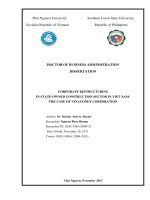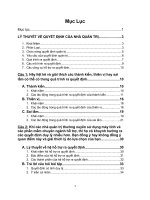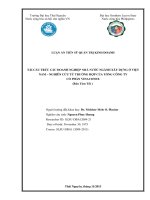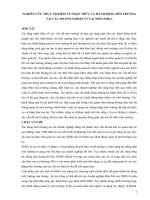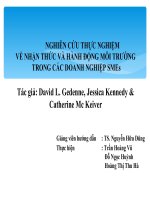Nghiên cứu hành vi của nhà quản trị trong việc ra quyết định tài chính đối với các doanh nghiệp việt nam tomtat e
Bạn đang xem bản rút gọn của tài liệu. Xem và tải ngay bản đầy đủ của tài liệu tại đây (830.14 KB, 28 trang )
1
MINISTRY OF EDUCATION AND TRAINING
UNIVERSITY OF ECONOMICS HO CHI MINH CITY
--------------------
TRUONG DINH BAO LONG
RESEARCH ON CEO’s OVERCONFIDENT BEHAVIOR
AND FINANCIAL DECISIONS IN VIETNAM COMPANIES
Major:
Finance – Banking
Major code: 93 40201
DOCTORAL THESIS SUMMARY
HOCHIMINH CITY – 2018
2
The thesis is completed at:
University of Economics Ho Chi Minh City
Supervisor:
Associate Professor. Ph.D Nguyen Ngoc Dinh
Contradicteur 1: …………………….……………………..
Contradicteur 2: ………………………..……………………
Contradicteur 3: ………………………………………………..
The thesis will be defensed in front of the Academic Council convened by:
…………………………………………………………………………………
At: …… …../……/201…
This thesis can be found at the library:
………………………………………………………………………………..
3
SOCIAL REPUBLIC OF VIETNAM
Independence – Freedom – Happiness
Ho Chi Minh City, 5th Oct. 2018
ABSTRACT OF THE THESIS
Thesis title: Research on CEO’s overconfident behavior and financial
decisions in Vietnam companies.
Major:
Finance- Banking
Code: 93 40201
PhD Student:
Truong Dinh Bao Long
Supervisor:
Associate Professor. PhD Nguyen Ngoc Dinh,
Course: NCS2010
Keywords:
Overconfidence, Financial Condition Index, Financial
Decisions, Regression Model, CEO (Chief Executive Officer).
4
CHAPTER 1. INTRODUCTION TO THE APPROACH OF THE
THESIS
1.1. The necessity of the Thesis
Nowadays, in Vietnam, CEOs, who directly manage business activities, are often
struggled to make good decisions. Insufficient and inconsistent data, untransparent
market, asymmetric information are the main causes leading to biased CEOs’
decisions. This problem may become very serious and create agency cost for
stockholders, it indirectly reduces the value of the company. In other cases,
companies can be distressed and bankrupted if such problems are not solved
completely.
Although doing research on CEOs’ behaviors is very important in order to contribute
to the theoretical and empirical framework in making right decisions, it is only
implemented in the U.S market. Therefore, it is necessary to implement and conduct
a similar research in Vietnam market because the research can reveal a specific
relationship between behavioral psychology and financial theories.
In types of behavior which may affect business decisions, overconfidence is the most
featured and is measured almost accurately, so this point is fundamental to focus on
this kind of behavior rather than others. Most hypotheses, which are used in the thesis,
are based on the U.S market; however, some of them are reasoned and transformed
to reflect the core of the Vietnam market. In addition, the hypothesis test stage is also
used to accept or reject the hypotheses and make sure the robustness of the results. In
summary, the necessity of the thesis is to find out whether CEOs’ behavior affects
financial decisions, whether it is a good or bad relationship, then what
recommendations can be given for the business.
5
1.2. A brief of the Literature Review
The thesis is closely related to the literature about the relationship between
overconfidence and corporate financial policies. Malmendier and Tate (2005) prove
that companies, which are managed by overconfident CEOs, has the higher sensitivity
of internal cash flow than those being run by rational CEOs. Malmendier and Tate
(2008) suppose overconfident CEOs are likely to involve in takeovers, so the value
of the companies is decreased. Malmendier et al (2011) argue that when recognizing
that the value of the company is underestimated, the CEO tends to avoid more
external fundings. Valeria Fedyk (2013) notes that CEO’s confidence causes two
main impacts on the funding decisions. The first impact is that overconfident tends to
raise more debt and stocks to invest in potential projects. They prefer using debt to
using stock to raise fund; if CEOs estimate that the internal values of their stocks are
higher than the market values of the stocks, reasonably they will sell new stocks to
the market. Moreover, Bouwman (2009) analyze the changes in the stock price and
an increase of dividend in companies having optimistic CEOs.
In addition, the topic about the relationship between CEO’s overconfidence and
financial decisions is quite new in Vietnam. Recently, it received many concerns from
domestic scholars. For example, Nguyen Ngoc Dinh (2015) and Le Dat Chi (2015)
find out some weak evidence about overconfidence can affect financial decisions.
However, the methodology of overconfidence measurement is still a challenge in
Vietnam. In this thesis, overconfidence measurement is improved significantly to
those two previous papers to avoid the endogeneity.
1.3. The aim of the Thesis
Determining the existence of the relationship between overconfidence and investment
decision in Vietnam. Determining the existence of the relationship between
overconfidence and investment decision in Vietnam under the effect of the financial
conditions. Determining the existence of the relationship between overconfidence
6
and funding decision in Vietnam. Determining the existence of the relationship
between overconfidence and funding decision in Vietnam under the effect of a
financial deficit. Determining the existence of the relationship between
overconfidence and dividend decision in Vietnam. Determining the existence of the
relationship between overconfidence and dividend decision in Vietnam under the
effect of growth opportunity.
1.4. The methodology of the Thesis
The thesis uses regression models on the basis of the previous papers in the U.S
market. The variables and the way to collect data are similar to obtain the aim of the
thesis.
Space dimension of the sample: Sample size includes 136 Vietnamese businesses full
of the audited financial statement and publicly listed in Ho Chi Minh Stock Exchange
and Ha Noi Stock Exchange.
Time dimension of the sample: The data is collected from 2007 to 2016, in which four
first years from 2007 to 2010 will be used to calculate net buying position to confirm
the behavior of CEOs.
1.5 A brief of the results in the Thesis
Firstly, CEO overconfidence does not affect directly on the sensitivity of investmentcashflow. Secondly, the financial condition plays an important role in reducing the
sensitivity of investment-cashflow. Thirdly, based on effective and efficient
estimation models, the thesis finds out that CEO overconfidence increases the
sensitivity of using debt under the effect of the financial deficit. Fourthly, although
there is no evidence to prove that CEO overconfidence affects the capital structure of
the company, under the effect of financial conditions there is a weak evidence that
overconfident CEOs reduce the financial leverage of the company. Fifthly,
overconfident CEOs pay more dividend than rational ones do. Finally, under the
7
effect of growth opportunities, overconfident CEOs still pay more dividend than
rational ones do.
1.6 The meaning of the Thesis
The thesis partly contributes empirical evidence related to three financial decisions
(investment, funding, dividend). This thesis also makes clear the relationship between
CEO overconfidence and financial decisions in the Vietnam market. Investors,
managers, stockholders, and related parties can use the implication of the thesis to
determine the sign of the business (Does the business face debt risk? Is the CEO
overconfident? Is dividend too high?)
1.7 The structure of the Thesis
In addition to the table of contents, abbreviation list, tables, annex and the Chapter 1
here. The thesis includes four remaining chapters as follows: Chapter 2. Theoretical
framework and literature review. Chapter 3. The methodology of the thesis. Chapter
4. The results of the thesis. Chapter 5. The conclusions and implications of the thesis.
CHAPTER 2.
THEORETICAL
FRAMEWORK AND
LITERATURE
REVIEW
2.1 Theories of Behavioral Finance about the Biased Recognition
2.1.1. Incomplete rational: Restrictive rational
Some theoretical behavioral finance models show that subjects do not adjust their
belief in the right way when new information arrives. It means the adjustment does
not follow the Bayes rule. Other models believe that subjects’ belief flows Bayes
rules but their behavior is not appropriate with the expected subjective utility.
Therefore, these are the motivation of researchers to discover psychological
8
recognition of the subjects. From that, behavioral financial models (behavioral
economics) are based on the irrational behavior of the subjects resulting from the
biasness in the personal belief and interest. The models are designed to explain how
subjects can create their expectations.
2.1.2. Cognitive psychology: Biased patterns in Behavior
Heuristics or the rule of experiences is a thinking activity based on experienced
events, it helps the subject make decisions easier. Cognitive accounting is a type of
behavior which helps the subject separate different decisions of the same resource.
This term is first expressed by Thaler (1985), when he tries to depict a process of
human in which the economic results are standardized, classified and evaluated.
Later, Ritter (2003) contribute a descriptive process to make the model complete.
Another term given by Shefrin and Thaler, 1988 is framing. Framing is a social
scientific term including a set of definitions and description in which the subjects and
organizations recognize and approach the reality. The human tends to underestimate
the long-run events and overestimate the most recent ones (Ritter, 2003). Almost all
people have a strong, unrealistic and optimistic belief in their abilities (Weinstein,
1980). Especially, businessmen and senior managers tend to be overconfident. Ritter
(2003) gives the examples of low diversity which results from the familiarity of those.
Barber and Odean (2001) analyze the history of transactions and show that the more
brokers trade, the worse their performance is.
2.1.3. The overconfidence of managers in Behavioral Financial Theories
Nowadays, although senior managers are educated and trained professional
knowledge and leadership skills very well, they are irrational and make wrong
decisions for many reasons. Almost all of the reasons result from the impact of
emotion on decisions. Besides, even if a CEO is considered as perfect, he must also
base on his sentiment to make decisions because of insufficient information.
Therefore, it is hard for a person to give a good conclusion on what they observe. The
9
reality is too different from the hypothesis of rational subjects. This is the main cause
explaining why a manager is irrational and biased in his decisions.
2.2 Overconfidence and CEO Overconfidence
According to De Bondt and Thaler (1995), “Findings that people have
overconfidence in their instinct perhaps are the most consistent findings in the
psychology of making decisions”. Malmendier and Tate (2005) note that managers
especially senior ones tend to be affected by misperception and overconfidence. They
always face complex and abstract situations although they are limited by their
knowledge. Therefore, they often commit themselves to achieve targets in a high
level, so that makes them fall into the overconfidence.
2.3 The approaches of CEO Overconfidence Measurement
Malmendier and Tate (2005a, 2005b, 2008) suggest two approaches to measure the
overconfidence of CEOs. The first approach is based on revealed beliefs or the option
and stock-based measure of CEO confidence. The second approach is based on the
way other people think of the CEO and is called the press-based measure of CEO
confidence.
2.3.1 Option and stock-based measure of CEO confidence
In this measure, there are some different methods: Holder 67, Holder 150,
Longholder and Net Buyer. CEO holds their options at a level that excess their
rational threshold of 67% or 150%, so those methods are Holder 67 and Holder 150,
respectively. CEO tries his or her best to hold the option 5 years longer from the
maturity point even though the value of options excesses their rational level. So, the
long holder measure is built on that basis. On the other hand, Net Buyer measure is
created to capture the tendency of buying more stocks of some CEOs although they
know the sensitivity of business risk.
2.3.2 Press-based measure of CEO confidence
10
This measure is based on the correlation between the number of articles about
overconfidence/optimistic and unconfidence/ pessimistic. According to Malmendier
and Tate (2005b, 2008), we can distinguish who is the overconfident CEO based on
the press. Following each CEO on each year, they collect keywords such as a)
Overconfident/
overconfidence,
b)
optimistic/
optimism,
c)
unconfident/
unconfidence, d) pessimistic/ pessimism, e) reliable, cautious, conservative,
practical, frugal or steady. They create a dummy index Totalconfident for each CEO
by time as follows:
𝑡−1
𝑡−1
𝑇𝑂𝑇𝐴𝐿𝑐𝑜𝑛𝑓𝑖𝑑𝑒𝑛𝑡𝑖𝑡 = {1 𝑛ế𝑢 ∑ 𝑎𝑖𝑠 + 𝑏𝑖𝑠 > ∑ 𝑐𝑖𝑠 + 𝑑𝑖𝑠 + 𝑒𝑖𝑠 ;
𝑠=1
𝑠=1
0 𝑜𝑡ℎ𝑒𝑟𝑤𝑖𝑠𝑒
2.4 The theories of CEO overconfidence and corporate financial decisions
On the aspect of investment, the theory is that CEO overconfidence impacts on
investment decisions on three approaches: First, overconfidence leads CEOs to overinvestment. Secondly, overconfidence increase the sensitivity of investmentcashflow. Finally, overconfidence leads CEOs to optimal investment. Heaton (2002)
shows that optimistic CEOs believe that projects will have higher cash flow and tend
to accept more projects. Malmendier and Tate (2005a) regress the sensitivity of
investment-cashflow to find out similar discoveries like Heaton (2002). Malmendier
and Tate (2005b) show that overconfident CEO will overestimate the future rate of
return; therefore, they will invest too much. Goel and Thakor (2008) show that
overconfident CEO, who are not risk-adverse, will invest more than the optimal
investment level. In terms of funding decision, Heaton (2002) and Hackbarth (2008)
investigate biasness in funding decisions via optimism/overconfidence. Those models
give them clues that optimistic and overconfident CEOs will choose the higher
financial leverage rate. Hackbarth (2008) argues that overconfident CEOs believe the
cash flow in their companies are less variated, then their companies have lower
chances to get distressed despite that this is not true. In terms of dividend policy,
11
Allen and Michaely (2003), Bouwman (2009), Sanjay Deshmukh et al (2013) give
out empirical evidence that overconfident CEO pays less dividend than rational CEO.
However, under the effect of growth opportunity, overconfident CEO pay more
dividend than usual.
CHAPTER 3. THE METHODOLOGY OF THE THESIS
Hypothesis 1: In companies which have overconfident CEOs, the sensitivity of
investment-cashflow is higher than in companies which have rational CEOs.
The thesis tests the hypothesis 1 via checking whether CEO confidence increases the
sensitivity of investment-cashflow. The empirical model is based on the one creating
by Malmendier and Zheng (2012) as follows:
𝐼𝑖𝑡 = 𝛽1 + 𝛽2 𝐶𝐹𝑖𝑡 + 𝛽3 𝑂𝐶𝑖 + 𝛽4 𝑂𝐶𝑖 ∙ 𝐶𝐹𝑖𝑡 + 𝛽5 𝑋𝑖𝑡′ + 𝛽6 𝑋𝑖𝑡′ ∙ 𝐶𝐹𝑖𝑡 + 𝜀𝑖𝑡 (1)
Where Iit denotes the investment (or capital expense – capex) of company i in year t
using the initial year as the benchmark. CFit denotes the cash flow of company i in
year t, standardized and winsorized at 1% according to the asset value of the initial
year. OCi represents the CEO overconfidence of company i and is a dummy variable.
Finally, X’it is a set of controlling variables for CEO and company properties.
Hypothesis 2: The sensitivity of investment-cashflow in companies which have
overconfident CEOs is affected by the effect of the funding deficit.
The static model of investment (1) has an issue that it has not considered the dynamics
and persistence of investment. For example, investment at this moment can depend
on the investment in the previous year, and investment is the reversal in the model
like this. Therefore, the model (2) is now different from the model (1). Firstly, Iit-1
plays an important role as an independent variable. Almost all variables are the same
12
as ones in the model (1) except for adding the FCI variable to present the impact of
macroeconomy on the model.
𝐼𝑖𝑡 = 𝛽1 + 𝛽2 𝐼𝑖𝑡−1 + 𝛽3 𝐶𝐹𝑖𝑡 + 𝛽4 𝑂𝐶𝑖 + 𝛽5 𝑂𝐶𝑖 ∙ 𝐶𝐹𝑖𝑡 + 𝛽6 𝐹𝐶𝐼𝑡 + 𝛽7 𝐹𝐶𝐼𝑡 ∙ 𝐶𝐹𝑖𝑡 +
𝛽8 𝑂𝐶𝑖 ∙ 𝐹𝐶𝐼𝑡 + 𝛽9 𝑂𝐶𝑖 ∙ 𝐹𝐶𝐼𝑡 ∙ 𝐶𝐹𝑖𝑡 + 𝑋𝑖𝑡′ Β10 + 𝑋𝑖𝑡′ ∙ 𝐶𝐹𝑖𝑡 Β11 + 𝜀𝑖𝑡 (2)
Hypothesis 3: Overconfident CEOs use higher financial leverage than rational ones.
Can CEO overconfidence be explained by the different capital structures in
companies?
More specifically, in this thesis, is there any differential in the debt level causing by
the financial deficit?
To do that, we can regress the below equation:
𝐿𝑒𝑣_𝑚𝑘𝑖𝑡 = 𝛽1 + 𝑋𝑖𝑡′ 𝐵2 + 𝛽3 𝑂𝐶𝑖 + 𝜀𝑖𝑡 (3)
Where, 𝐿𝑒𝑣_𝑚𝑘𝑖𝑡 is the debt leverage calculated by the market value of the company
i at the end of fiscal year t. 𝑋𝑖𝑡′ is the set of control variables. The composition of 𝑋𝑖𝑡′
is the fiscal deficit (FD), profitability (𝑃𝑟𝑜𝑓𝑖𝑡), tangible asset (𝑇𝑎𝑛𝑔), size of the
company (ln (Sales)), the growth opportunity (Q), ownership ratio of the CEO (Owp)
and all measured at the beginning of year t. In addition, the rest of 𝑋𝑖𝑡′ includes a
return on equity (𝑅𝑒𝑡𝑢𝑟𝑛𝑖𝑡−1 ), the term of the CEO (𝑇𝑒𝑛𝑢𝑟𝑒𝑖𝑡 ), and the financial
condition of the economy (𝐹𝐶𝐼𝑡 ). 𝑅𝑒𝑡𝑢𝑟𝑛𝑡−1 is the logarithmic rate of return over the
period from year t-2 to year t-1. Adding a return to the rate of return will reflect
changes in stock prices to the leverage ratio (Welch, 2004).
Hypothesis 4: Overconfident CEOs use more debt than rational CEOs to reduce
funding deficit.
Research on the influence of CEO overconfident on debt financing in the context of
the financial deficit under the approach of Malmendier et al. (2011) and Malmendier
and Zheng (2012). The equation is based on the theoretical framework of Shyam-
13
Sunder and Myers (1999) about the financial deficit of the company and is
empirically tested by Frank and Goyal (2003):
𝐷𝑒𝑏𝑡𝑖𝑡 = 𝛽1 + 𝛽2 𝐹𝐷𝑖𝑡 + 𝛽3 𝑂𝐶𝑖 + 𝛽4 𝑂𝐶𝑖 ∙ 𝐹𝐷𝑖𝑡 + 𝛽5 𝑋𝑖𝑡′ + 𝛽6 𝑋𝑖𝑡′ ∙ 𝐹𝐷𝑖𝑡 + 𝜀𝑖𝑡 (4)
Where Debtit denotes the net debt, which is calculated by using incremental debt of
the company i in the year t. FDit denotes the financial deficit of the company I in the
year t (it is calculated by adding up the cash dividend, net capital expense, net
working capital and then minusing for internal cashflow). Other variables have the
same as notations as the equation (1), (2) and (3) except for controlling variables.
Although the thesis still uses the same controlling variables as in the paper of Frank
and Goyal (2003) and Malmendier et al (2011), most variables are re-calculated on
the basis of the incremental changes. For instance, they are the change in profitability
(Δ𝑃𝑟𝑜𝑓𝑖𝑡𝑖𝑡 ), in tangible asset (Δ𝑇𝑎𝑛𝑔𝑖𝑡 ), in size of the company (Δln(𝑆𝑎𝑙𝑒𝑠)𝑖𝑡 ) and
in the growth opportunity (Δ𝑄𝑖𝑡 ).
Hypothesis 5: In companies which have overconfident CEOs, the dividend is less
than in companies which have rational CEOs.
Hypothesis 6: Rational CEOs pay more dividend than overconfident CEO under the
effect of growth opportunities.
According to Malmendier and Tate (2005, 2008) and Malmendier et al (2011), the
thesis classifies overconfident and rational CEO based on the investment level of
him/her in the company. The model presents the relationship between the CEO
overconfidence and dividend payment which results from the original paper of Sanjay
Deshmukh et al (2013):
𝐷𝐼𝑉𝑖𝑡 = 𝛽0 + 𝛽1 𝑂𝐶𝑖𝑡 + 𝛽2 𝑋𝑖′ (5)
Where the dependent variable is DIVit, is the total cash dividend on the market value
of the company stock in year t. And, controlling variables, 𝑋𝑖′ , contain a set of
14
variables as ownership rate on total common stock (Owp), growth opportunity
(Tobin’Q) and cash flow of the company I in year t, CFit.
Descriptive statistics
Variable
Obs
Mean
Std
Min
Max
Properties of CEO
OC
816
0.2588
0.4386
0
1
Owp
816
0.0621
0.0971
0.0000
0.5501
Tenure
816
9.7471
4.1874
9
I
816
0.0527
0.0831
0.0000
0.9464
CF
816
0.0928
0.0876
-0.0656
0.4193
Debt
816
0.0018
0.0645
-0.2713
0.5603
Equity
816
0.0043
0.0281
-0.1609
0.2259
FD
816
0.0061
0.0696
-0.2713
0.5603
Profit
816
0.1204
0.0964
-0.1725
0.6505
Tang
816
0.2677
0.2101
0.0003
1.2095
ln(Sales)
816
13.2743
1.4036
8.9692
17.0552
Q
816
0.9560
0.3488
0.3785
3.3435
Lev_bk
816
0.3621
0.2548
0.0000
0.8725
Lev_mk
816
0.4337
0.3057
0.0000
0.9413
Return
816
-0.1998
0.5071
-1.7460
0.8629
-0.1203
0.5604
-1.0213
0.4788
34
Properties of company
Financial conditional index
FCI
816
15
CHAPTER 4. THE RESULTS OF THE THESIS
After regressing a sample data including 136 non-financial listed company which is
collected from both HNX and HSX exchanges on the period from 2011-2016, the
thesis has found some profound evidence.
Firstly, in Vietnam, CEO confidence does not impact on the sensitivity of investment
and cashflow. This evidence seems to be different from that of Manmeldier et al
(2005, 2008, 2012). Secondly, the financial condition plays an important role in
reducing the sensitivity of investment-cashflow. Thirdly, based on effective and
efficient estimation models, the thesis finds out that CEO overconfidence increases
the sensitivity of using debt under the effect of financial deficit. Fourthly, although
there is no evidence to prove that CEO overconfidence affects the capital structure of
the company, under the effect of financial conditions there is a weak evidence that
overconfident CEOs reduce financial leverage of the company. Fifthly, overconfident
CEOs pay more dividend than rational ones do. Finally, under the effect of growth
opportunities, overconfident CEOs still pay more dividend than rational ones do.
Table 4.1 CEO overconfidence and the sensitivity of investment - cashflow
Dependent variable: I(t)
Independent variable:
CF
OC
(1)
(2)
(3)
(4)
(5)
(6)
Pooled
Pooled
Pooled
Pooled
Pooled
GMM-
OLS
OLS
OLS
OLS
OLS
CUE
0.2702
0.3436
0.3918
0.3750
1.1163
0.3051
(4.08)***
(2.53)**
(2.24)**
(1.99)**
(0.65)
(0.5)
0.0266
0.0230
0.0427
0.0062
(1.12)
(0.74)
(1.06)
(0.49)
16
OC*CF
-0.2087
-0.1731
-0.2927
0.0675
(-0.93)
(-0.72)
(-0.91)
(0.33)
Yes
Yes
Yes
Yes
Yes
Yes
Yes
Yes
Yes
Yes
Yes
Yes
Yes
CEO-level Control
CEO-level Control*CF
Firm-level Control
Yes
Firm-level Control*CF
Year Fixed Efffects
Yes
Year Fixed Efffects*CF
Firm Fixed Effects
Intercept
Obs
R-squared
Arellano-Bond
test
for
test
for
AR(1) (p-value)
Arellano-Bond
AR(2) (p-value)
Yes
Yes
Yes
Yes
Yes
0.0277
-0.0229
-0.0277
-0.0790
0.0034
-0.0526
(4.86)***
(1.7)*
(1.6)
(-0.34)
(0.01)
(-0.91)
816
816
816
816
816
544
0.081
0.4982
0.4999
0.5052
0.5155
0.2620
0.0806
0.0050
Sargan J test (p-value
0.0511
Hansen J test (p-value)
0.6434
All standard deviations (in the parenthesis) are adjusted errors to adapt to
heteroskedasticity. GMM-CUE is used because it is beneficial and effective to solve
the cases in which heteroskedasticity and autocorrelation exist. GMM-CUE use the
first lag of Q and all interactive variables with CF and dummy variable as its
instrument varibles. ***, **, * are significance levels at 1%, 5% and 10%,
respectively. Hausman test is used to check whether FEM or REM is more suitable.
(H0: REM is better).
17
Table 4.2 CEO overconfidence and the sensitivity of investment – cashflow
under the effect of investment - cashflow
Dependent variable: I(t)
Independent variable:
I(t-1)
CF
OC
OC*CF
(1)
(2)
(3)
(4)
(5)
(6)
SGMM
SGMM
SGMM
SGMM
SGMM
SGMM
0.2644
0.2871
0.2890
0.2800
0.2874
0.2919
(3.47)***
(4.18)***
(4.32)***
(4.01)***
(3.94)***
(4.17)***
0.1692
0.1658
0.1668
0.1695
0.0324
(0.21)
(0.19)
(0.19)
(0.18)
(0.03)
0.0103
0.0114
0.0093
-0.0008
-0.0001
-0.0001
(0.93)
(1.01)
(0.87)
(-0.05)
(-0.01)
(-0.01)
-0.1072
-0.1318
-0.1306
0.0880
0.0829
0.0588
(-0.54)
(-0.64)
(-0.65)
(0.37)
(0.32)
(0.24)
-0.0196
FCI
(-0.63)
FCI*CF
OC*FCI
OC*FCI*CF
0.1275
0.1143
(0.51)
(0.47)
0.0436
0.0382
0.0332
(1.21)
(1.29)
(0.93)
-0.9127
-0.8893
-0.8577
(-2.8)***
(-2.69)***
(-2.74)***
CEO-level Control
Yes
Yes
Yes
Yes
Yes
Yes
CEO-level Control*CF
Yes
Yes
Yes
Yes
Yes
Yes
Firm-level Control
Yes
Yes
Yes
Yes
Yes
Yes
Firm-level Control*CF
Yes
Yes
Yes
Yes
Yes
Yes
18
Year Fixed Efffects
Yes
Year Fixed Efffects*CF
Yes
Yes
Yes
Yes
Firm Fixed Effects
Yes
Yes
Yes
-0.0255
-0.0258
-0.0242
(-0.39)
(-0.37)
(-0.35)
544
544
544
0.1500
0.1390
0.0361
Sargan J test (p-value)
Hansen J test (p-value)
Intercept
Obs
Arellano-Bond test for
AR(1) (p-value)
Arellano-Bond test for
AR(2) (p-value)
Yes
Yes
Yes
Yes
544
544
544
0.1380
0.1470
0.1470
0.1450
0.0282
0.1098
0.0436
0.0337
0.0693
0.0704
0.0628
0.0479
0.0832
0.0059
0.2620
0.8590
0.6740
0.6010
0.8780
0.6320
0.3840
All standard deviations (in the parenthesis) are adjusted errors to adapt to
heteroskedasticity. GMM-IV is adjusted for the autocorrlation and error cases.
SGMM (System GMM) uses instrument variables including all controlling
variables and dummy variables. ***, **, * are significance levels at 1%, 5% and
10%, respectively. Hausman test is used to check whether FEM or REM is more
suitable. (H0: REM is better).
Table 4.3 CEO overconfidence and the capital structure
Dependent variable: Lev_mk
Independent
variable:
FD
(1)
(2)
(3)
(4)
(5)
(6)
(7)
(8)
P-OLS
REM
REM
FEM
REM
FEM
GMM -IV
GMM -IV
0.5623
0.2749
0.2654
0.2354
0.2118
0.2240
0.4425
0.4586
(5.55)***
(3.24)***
(3.22)***
(3.03)***
(2.19)**
(2.28)**
(2.72)***
(2.84)***
19
Profit
Tang
ln(Sales)
Q
-0.7351
0.1417
0.1387
0.1099
0.1043
0.1081
-0.6323
-0.6213
(-3.98)***
(1.10)
(1.44)
(0.74)
(0.67)
(0.71)
(-2.62)***
(-2.43)**
0.1190
-0.0260
-0.0247
-0.0122
-0.0236
-0.0315
0.2437
0.2544
(1.04)
(-0.17)
(-0.13)
(-0.08)
(-0.15)
(-0.20)
(2.45)**
(2.19)**
0.0763
0.0443
0.0476
0.0380
0.0357
0.0370
0.0556
0.0556
(4.47)***
(0.89)
(0.81)
(0.79)
(0.72)
(0.74)
(3.07)***
(2.79)***
-0.2018
-0.0334
-0.0369
0.0544
0.0303
0.0251
-0.1863
-0.1900
(-3.41)***
(-1.02)
(-1.51)
(0.41)
(0.61)
(0.51)
(-3.14)***
(-3.01)***
0.5864
0.5919
0.2539
0.3654
-0.0262
-0.0263
(5.65)***
(5.93)***
(1.18)
(1.59)
(-0.21)
(-0.19)
-0.0524
-0.0483
-0.0459
-0.0198
-0.0015
(-2.71)***
(-2.09)**
(-2.00)**
(-0.31)
(-0.03)
0.6010
0.6036
0.9507
0.9800
(1.32)
(1.31)
(3.22)***
(3.02)***
-0.1236
-0.1227
-0.0129
-0.0129
(-5.81)***
(-5.76)***
(-3.19)***
(-2.9)***
-0.0149
-0.0282
0.0097
0.0109
(-0.6)
(-1.07)
(1.00)
(1.07)
OC
Return
Owp
Tenure
Tenure*OC
FCI
FCI*OC
Intercept
Firm Fixed
Effects
Year Fixed
Effects
0.2852
-0.0351
(4.49)***
(-0.39)
0.0457
-0.3303
(1.49)
(-1.84)*
-0.3393
-0.4994
-0.3697
-0.4658
0.7594
1.0353
-0.1133
-0.0954
(-1.4)
(-0.77)
(-0.78)
(-0.74)
(0.91)
(1.17)
(-0.47)
(-0.36)
Yes
Yes
Yes
Yes
Yes
Yes
Yes
Yes
Yes
Yes
Yes
20
Obs
R-squared
Hausman
test
816
816
816
816
816
816
544
544
0.2668
0.8771
0.8771
0.8831
0.8880
0.8888
0.7718
0.7716
0.1394
0.2549
0.033
0.1671
0.0431
0.2138
0.1099
0.0355
0.0681
0.3412
0.2246
0.1908
0.3270
ArellanoBond
for
test
AR(1)
(p-value)
ArellanoBond
for
test
AR(2)
(p-value)
Sargan J test
(p-value)
Hansen
test
J
(p-
value)
All standard deviations (in the parenthesis) are adjusted errors to adapt to heteroskedasticity.
GMM-IV is adjusted for the autocorrlation and error cases. GMM-IV uses instrument variables
including two differntial values of Retur and dummy variables. ***, **, * are significance
levels at 1%, 5% and 10%, respectively. Hausman test is used to check whether FEM or REM
is more suitable. (H0: REM is better).
21
Table 4.4 CEO overconfidence and funding decision under the effect of financial
deficit
Dependent variable: Debt(t)
Independent variable:
FD
(1)
(2)
(3)
(4)
(5)
(6)
P-OLS
REM
FEM
REM
FEM
GMM-CUE
0.8484
0.8454
0.8350
0.8091
0.3275
0.7362
(14.63)***
(11.96)***
(10.09)***
(9.29)***
(1.75)*
(5.04)***
-0.0345
-0.0354
-0.0115
-0.0032
(-2.67)***
(-3.03)***
(-0.96)
(-1.18)
0.0385
0.0872
0.3478
0.2644
(0.24)
(0.61)
(2.40)**
(2.02)**
Yes
Yes
Yes
Yes
Yes
Yes
Yes
Yes
Yes
Yes
Yes
Yes
Yes
OC
OC*FD
CEO-level Control
CEO-level Control*FD
Firm-level Control
Yes
Firm-level Control*FD
Year Fixed Efffects
Yes
Year Fixed Efffects*FD
Firm Fixed Effects
Intercept
Obs
R-squared
Yes
Yes
Yes
Yes
Yes
-0.0034
0.0236
0.0233
0.0185
0.0106
-0.0006
(-2.72)***
(10.42)***
(8.77)***
(2.2)**
(1.14)
(-0.31)
816
816
816
816
816
255
0.8377
0.8786
0.8789
0.8877
0.9217
0.9339
5395.1
5612.8
5507.3
5441.9
3.39***
3.01***
2.06**
3.27***
0.1137
0.0409
0.0778
0.0131
Log likelihood
χ2
Hausman test
0.0103
22
Arellano-Bond
test
for
test
for
0.2345
AR(1) (p-value)
Arellano-Bond
0.6395
AR(2) (p-value)
Sargan J test (p-value)
0.4066
Hansen J test (p-value)
0.6197
All standard deviations (in the parenthesis) are adjusted errors to adapt to heteroskedasticity.
GMM-CUE is used because it is beneficial and effective to solve the cases in which
heteroskedasticity and autocorrelation exist. GMM-CUE use the first differential value of FD
and all interactive variables with FD as its instrument varibles. ***, **, * are significance
levels at 1%, 5% and 10%, respectively. Hausman test is used to check whether FEM or REM
is more suitable. (H0: REM is better).
Table 4.5 CEO overconfidence and dividend decision
Dependent variable: Div
Independent
variable:
Owp
OC
Q
CF
ln(Sales)
(1)
(2)
(3)
(4)
(5)
(6)
(7)
FEM
FEM
REM
FEM
FEM
FEM
GMM - IV
122.6069
117.5162
131.0627
78.4912
122.2074
127.2179
-18.3563
(0.89)
(0.86)
(0.85)
(0.57)
(0.89)
(0.92)
(-0.72)
3.4715
3.0757
3.5166
3.1923
3.5245
3.6316
61.2179
(2.12)**
(2.30)**
(1.99)**
(2.24)**
(2.12)**
(2.18)**
(2.11)**
13.3328
15.0564
18.8671
1.4322
13.2850
13.9865
53.5833
(1.02)
(1.15)
(1.16)
(0.10)
(1.01)
(1.06)
(1.60)
0.4829
1.0373
0.7372
0.4854
0.3267
0.4686
1.8409
(0.21)
(0.29)
(0.36)
(0.14)
(0.09)
(0.13)
(0.41)
-0.3780
-0.3813
-0.5769
-0.4535
-0.3768
-0.3878
0.3442
(-0.70)
(-0.71)
(-0.81)
(-1.61)
(-0.70)
(-0.72)
(0.20)
23
0.5531
Tenure
(1.82)*
0.6568
Lev_bk
(0.55)
-2.50e-14
Tang
(-0.03)
0.2972
OC*Q
(2.33)**
2.7280
OC*CF
(0.18)
-5.58e-13
OC*Tang
(-0.41)
Intercept
Year
Fixed
Efffects
Firm
Fixed
Effects
Obs
Log
likelihood
χ2
Hausman
test
-14.0467
-17.5667
-20.0043
-1.1711
-13.9973
-14.7461
-73.7374
(-1.03)
(-1.28)
(-1.18)
(-0.08)
(-1.02)
(-1.07)
(-1.73)*
Yes
Yes
Yes
Yes
Yes
Yes
Yes
Yes
Yes
Yes
Yes
Yes
Yes
Yes
816
816
816
816
816
816
544
5180.49
4512.71
2511.24
4513.62
4476.41
4529.13
527.49***
283.21***
572.45***
422.22***
553.42***
387.62***
0.0316
0.0051
0.1738
0.0019
0.0012
0.0372
ArellanoBond test for
AR(1)
value)
(p-
0.1513
24
ArellanoBond test for
AR(2)
(p-
0.0967
value)
Sargan J test
(p-value)
Hansen J test
(p-value)
0.3671
0.897
All standard deviations (in the parenthesis) are adjusted errors to adapt to heteroskedasticity.
GMM-IV uses instrument variables including two differntial values of Return and dummy
variable. ***, **, * are significance levels at 1%, 5% and 10%, respectively. Hausman test is
used to check whether FEM or REM is more suitable. (H0: REM is better).
CHAPTER 5. THE CONCLUSIONS AND IMPLICATIONS OF THE THESIS
5.1. Main conclusions
Hypothesis 1: In companies which have overconfident CEOs, the sensitivity of
investment-cashflow is higher than in companies which have rational CEOs.
Although on the whole investment is affected by cash-flow, in both dynamic and
static models, there is no evidence of the relationship between CEO overconfidence
and the sensitivity of investment-cashflow. The interactive coefficient of CEO
overconfidence and cashflow has no statistical significance.
Hypothesis 2: The sensitivity of investment-cashflow in companies which have
overconfident CEOs is affected by the effect of the funding deficit. CEO
overconfidence affects the sensitivity of investment-cashflow under the effect of
macro-financial conditions. The thesis shows that CEO overconfidence has an
indirect role in that relationship. Particularly, the impact has the negative sign and
there are levels in the range of 0.86 to 0.91. That means CEO overconfidence reduces
the effect of (good) financial conditions on the sensitivity. This implies that
25
overconfident CEOs overestimate the internal cashflow. Then, CEOs think positively
about the potential projects if the financial conditions are good. They invest more in
those projects and do not care much for the internal cashflow. The thesis supposes
that CEO are joining in the debt market where the hypothesis 2 supports for the
hypothesis 1. Moreover, under the effect of financial deficit and good financial
conditions, it is understandable that the sensitivity of investment-cashflow can be
reduced. To understand deeply this case, we should consider the relationship between
CEO overconfidence and funding decision under the financial deficit.
Hypothesis 3: Overconfident CEOs use more debt than rational CEOs to reduce
funding deficit. One more, similar to hypothesis 1, the thesis has no evidence for the
hypothesis 4 on the sample of 136 Vietnamese companies with various models. It is
easy to see that when the financial market becomes better after the financial crisis
2017-2018, overconfident CEOs tend to reduce debt to support for their projects.
However, it is interesting that CEO overconfidence reduces the effect of financial
conditions on market leverage (lev_mk) despite that it is weak evidence. In addition,
the coefficient of FCI has no statistical significance because of the interactive
coefficient of FCI.OC. Surprisingly, compared to rational CEOs, overconfident CEOs
tends to reduce financial leverage rate when the financial conditions are better and
vice versa.
Hypothesis 4: Overconfident CEOs use higher financial leverage than rational ones
when funding the financial deficit from external sources. The thesis has findings
supporting this hypothesis. The estimation result is closely related to the results in the
hypothesis 4 later on in which CEO overconfidence impacts on funding decisions
under the financial deficit. GMM models are used to improve the robustness in the
argument. Particularly, the result of Hansen J test cannot reject the feasibility of
instrument variables while that of Arellano-Bond cannot reject the absence of the
autocorrelation (I) and (II) in the model.

